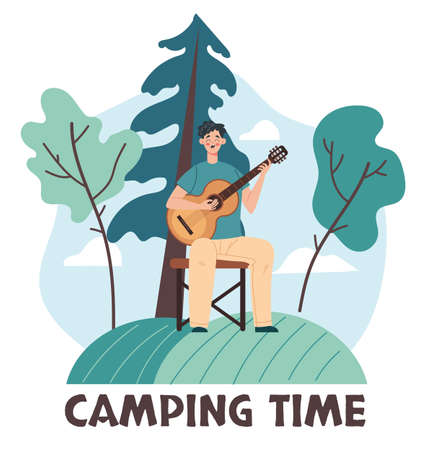1. Planning Your Shenandoah Adventure
Before pitching your tent in the heart of Virginia’s Blue Ridge Mountains, a little planning goes a long way. Shenandoah National Park is a year-round destination, but the experience can vary greatly depending on when you go and how well-prepared you are. Here’s what you need to know to kick off your camping adventure right.
Choosing the Best Season to Visit
Each season in Shenandoah offers something unique:
| Season | What to Expect | Best For |
|---|---|---|
| Spring (March – May) | Blooming wildflowers, fewer crowds, cool temps | Hiking, photography, peaceful getaways |
| Summer (June – August) | Warm weather, family-friendly activities, popular time | Family camping, ranger programs, swimming nearby |
| Fall (September – November) | Spectacular foliage, crisp air, busy weekends | Scenic drives, leaf-peeping, cozy campfires |
| Winter (December – February) | Quiet trails, snowy landscapes, limited services | Backcountry solitude, snowshoeing |
Permits and Reservations: What You Need to Know
If youre planning to camp at one of the parks developed campgrounds—like Big Meadows or Loft Mountain—you’ll want to book early during peak seasons. Reservations can be made through Recreation.gov up to six months in advance. For backcountry camping, a free permit is required and can be obtained online or at park visitor centers.
Campground vs Backcountry Camping Overview:
| Type | Reservation Needed? | Amenities | Best For |
|---|---|---|---|
| Developed Campgrounds | Yes (recommended) | Restrooms, fire rings, picnic tables, water access | Families, RVs, first-time campers |
| Backcountry Camping | No reservation; permit required | No amenities; Leave No Trace required | Experienced hikers, solitude seekers |
Navigating Entry Points and Park Regulations
The main entry into Shenandoah is via Skyline Drive—a scenic route that runs the entire length of the park. There are four primary entrance stations: Front Royal (North), Thornton Gap (Central), Swift Run Gap (South-Central), and Rockfish Gap (South). Entry fees are typically $30 per vehicle for a 7-day pass or $55 for an annual pass specific to Shenandoah.
Important Rules to Keep in Mind:
- No dispersed roadside camping: All overnight stays must be in designated areas or with a backcountry permit.
- Bears live here: Use bear-proof storage and never leave food unattended.
- Packed-in = packed-out: Always follow Leave No Trace principles.
- No cell service in many areas: Download maps ahead of time.
Ahead of your visit, make sure to check current trail conditions and alerts on the official Shenandoah National Park website. With just a bit of preparation, your adventure in the Blue Ridge Mountains will be as smooth as it is unforgettable.
2. Top Campgrounds and Backcountry Sites
Whether youre a first-time camper or a seasoned backpacker, Shenandoah National Park offers a wide range of camping options. From easily accessible front-country campgrounds with amenities to remote backcountry sites for true wilderness lovers, theres something here for everyone.
Popular Front-Country Campgrounds
If you prefer camping with nearby facilities like restrooms, fire pits, and even camp stores, front-country campgrounds are your best bet. These campgrounds are perfect for families, RV travelers, and those looking to enjoy nature without straying too far from comfort.
| Campground | Location | Key Features | Best For |
|---|---|---|---|
| Big Meadows | Mile 51 on Skyline Drive | Flush toilets, hot showers, camp store, visitor center nearby | Families, photographers (great views and wildlife) |
| Loft Mountain | Mile 79.5 on Skyline Drive | Largest campground in the park, panoramic views, access to Appalachian Trail | Hikers, group campers, RVs |
| Lewis Mountain | Mile 57.5 on Skyline Drive | More secluded, smaller campground, close to Big Meadows amenities | Couples, small groups seeking quiet atmosphere |
| Mathews Arm | Mile 22.1 on Skyline Drive | Closest to the park’s northern entrance, good access to Overall Run Falls trail | First-time visitors, waterfall seekers |
Hidden Backcountry Gems
If youre looking for solitude and adventure, Shenandoah’s backcountry is calling. With over 500 miles of trails and dozens of designated backcountry campsites, experienced hikers can truly immerse themselves in the Blue Ridge wilderness. Remember to get a free backcountry permit before heading out!
Campsite Highlights:
- Doyles River Area: This area offers peaceful spots near waterfalls and streams — great for an overnight loop hike.
- Pinefield Hut Vicinity: Popular among Appalachian Trail hikers; offers primitive shelter and open forest campsites.
- Hazel Mountain: A lesser-known gem with dense forest surroundings and fewer crowds.
- Riprap-Wildcat Ridge Loop: Challenging terrain but rewarding views and private campsites along the way.
Backcountry Tips:
- Always follow Leave No Trace principles.
- Bears are active — bring a bear canister or hang your food properly.
- Water sources are available but must be treated before drinking.
- No fires allowed in most backcountry areas — bring a backpacking stove.
From well-equipped family-friendly campgrounds to serene mountain hideaways deep in the woods, Shenandoah National Park caters to every kind of camper. Whether you’re waking up to sunrise at Big Meadows or stargazing by a quiet stream miles from the nearest road, these experiences make every trip unforgettable.

3. Blue Ridge Mountain Hiking and Activities
Shenandoah National Park is a dream destination for outdoor lovers, especially hikers. Nestled in the heart of the Blue Ridge Mountains, the park offers over 500 miles of trails, including 101 miles of the famous Appalachian Trail. Whether youre looking for a peaceful nature walk, a challenging mountain hike, or a scenic overlook to catch a stunning sunrise, there’s something for everyone.
Must-Do Hikes Along the Appalachian Trail
The Appalachian Trail (AT) runs through the length of Shenandoah National Park and features some of the most iconic hikes in the region. You don’t have to be a thru-hiker to enjoy it—many sections are perfect for day hikes.
| Hike | Distance (Round Trip) | Highlights |
|---|---|---|
| Mary’s Rock via AT | 3.7 miles | Panoramic views of Thornton Gap and Skyline Drive |
| Stony Man Trail | 1.6 miles | Easy hike with one of the best viewpoints in the park |
| Blackrock Summit | 1 mile | Boulder field and sweeping vistas; great for families |
Scenic Overlooks You Can’t Miss
If hiking isn’t your thing, don’t worry—Skyline Drive has over 70 scenic overlooks where you can soak in breathtaking views without breaking a sweat. Some popular stops include:
- Skyland Overlook: Gorgeous during sunrise or fall foliage season.
- Crescent Rock: A quiet spot with views into the Shenandoah Valley.
- Baldface Mountain Overlook: Offers a unique view of the rolling hills and dense forest below.
Waterfall Trails Worth Exploring
The park is home to several waterfall hikes that range from easy walks to strenuous climbs. These trails are especially refreshing in spring and early summer when water flow is at its peak.
| Trail Name | Distance (Round Trip) | Waterfall Height |
|---|---|---|
| Dark Hollow Falls | 1.4 miles | 70 feet |
| Whiteoak Canyon Trail | 4.6 miles (to Lower Falls) | Multiple falls up to 86 feet |
| Doyles River Falls Trail | 3.2 miles | Main falls around 28 feet and 63 feet tiers |
Wildlife Watching Opportunities
Shenandoah is teeming with wildlife, making it a paradise for animal lovers and photographers alike. Keep your eyes open for white-tailed deer, black bears, wild turkeys, and even bobcats if you’re lucky. Early morning or late evening are the best times for sightings—just remember to keep a safe distance and never feed wild animals.
Tips for Wildlife Watching:
- Bring binoculars: Great for spotting birds and distant animals.
- Stay quiet: Wildlife is more likely to appear if youre calm and silent.
- Avoid strong scents: Perfumes or food smells can either attract or scare off animals.
No matter what kind of adventure you’re looking for, Shenandoah National Park’s Blue Ridge section offers activities that let you connect deeply with nature—from high mountain peaks to cool stream valleys filled with surprises at every turn.
4. Essential Gear and Packing Tips
When youre camping in Shenandoah National Park, being well-prepared can make the difference between a great adventure and a stressful trip. The Blue Ridge Mountains are beautiful but unpredictable, especially when it comes to weather. Heres a breakdown of essential gear you’ll need, tips for packing smart, and how to stay ready for anything Mother Nature throws your way.
Must-Have Camping Gear
Whether youre staying at a developed campground or venturing into backcountry sites, these are the basics youll want in your pack:
| Gear | Why You Need It |
|---|---|
| Tent with Rainfly | Weather in the Blue Ridge can change quickly—staying dry is key. |
| Sleeping Bag (Rated for 3 Seasons) | Nights can get chilly, even in summer. |
| Sleeping Pad or Air Mattress | Adds insulation and comfort on rocky or uneven ground. |
| Camp Stove or Portable Grill | Some campgrounds dont allow open fires; be ready to cook without one. |
| Headlamp or Lantern | You’ll need hands-free light for setting up after dark or late-night bathroom trips. |
| Bear-Proof Food Storage | Bears are active in Shenandoah—always store food properly. |
| First Aid Kit | Accidents happen—be ready to handle minor injuries. |
| Water Filter or Purification Tablets | Streams may look clean, but always purify before drinking. |
Packing Light Without Sacrificing Comfort
If youre hiking into a backcountry site or just want to keep things simple, here are some tips to trim down your load:
- Go Multi-Purpose: Use gear that serves more than one function—for example, a pot that doubles as a bowl.
- Layer Your Clothing: Pack lightweight layers instead of bulky items. This keeps you warm and gives flexibility as temperatures change.
- Use Compression Bags: These help shrink bulky items like sleeping bags and jackets to save space.
- Avoid Overpacking “Just in Case” Items: Stick to essentials and check the forecast before leaving home.
Preparing for Mountain Weather in Virginia’s Blue Ridge
The weather in Shenandoah can shift rapidly—sunny mornings can turn into stormy afternoons. Heres how to stay prepared:
| Condition | What to Pack |
|---|---|
| Rain & Thunderstorms | Poncho or rain jacket, waterproof tent cover, quick-dry clothing |
| Cool Nights (Even in Summer) | Insulated sleeping bag, thermal base layers, beanie hat |
| Hot Days with Strong Sun | Sunscreen, wide-brim hat, sunglasses, electrolyte tablets |
Quick Tip:
The higher you go in elevation, the cooler it gets—expect about a 5°F drop for every 1,000 feet of elevation gain. Always bring an extra layer if youre planning hikes up Old Rag or Hawksbill Mountain.
Don’t Forget These Extras!
- Pocket Knife or Multi-Tool: Handy for everything from food prep to gear repairs.
- Duct Tape: Great for patching tents, shoes, or backpacks on the fly.
- Campsite Permit & Map: Always have printed copies—even if you’re relying on your phones GPS.
A little preparation goes a long way when camping in Shenandoah National Park. With the right gear and smart packing strategies, youll be ready to enjoy all that the Blue Ridge Mountains have to offer—rain or shine.
5. Staying Safe and Leave No Trace Principles
Camping in Shenandoah National Park offers unforgettable views, peaceful forests, and a real chance to connect with nature. But staying safe and protecting the park’s natural beauty go hand-in-hand. Whether youre hiking the Appalachian Trail or setting up camp at Big Meadows, understanding safety basics and following Leave No Trace principles is key to having a great—and responsible—outdoor experience.
Wildlife Encounters: Be Bear Aware
Shenandoah is home to a healthy population of black bears, white-tailed deer, and other wildlife. Seeing animals in their natural habitat is exciting, but its important to keep your distance—for your safety and theirs.
Bear Safety Tips:
- Store food properly: Use bear-proof lockers or hang food at least 10 feet off the ground and 4 feet from any tree trunk.
- No food in tents: Never bring snacks or scented items inside your tent, including toiletries.
- If you see a bear: Stay calm. Back away slowly while facing the bear. Never run.
Weather Preparedness: Pack for All Conditions
The weather in the Blue Ridge Mountains can change quickly—even in summer. It might be sunny in the valley and stormy on Skyline Drive just an hour later. Always check the forecast before heading out and pack layers for warmth and rain protection.
What to Pack Based on Weather
| Condition | What to Bring |
|---|---|
| Cool Nights (Spring/Fall) | Insulated jacket, thermal base layers, sleeping bag rated for low temps |
| Rain Showers (Year-Round) | Waterproof jacket, rain fly for your tent, quick-dry clothes |
| Hot Days (Summer) | Sunscreen, breathable clothing, extra water, sun hat |
Leave No Trace: Camp Responsibly
Shenandoah’s beauty depends on every visitor doing their part to protect it. Following Leave No Trace principles ensures that future generations can enjoy this special place too. Heres how you can minimize your impact:
The Seven Leave No Trace Principles
- Plan ahead and prepare: Know park regulations and trail conditions.
- Travel and camp on durable surfaces: Use established trails and campsites only.
- Dispose of waste properly: Pack out all trash—including biodegradable items like orange peels.
- Leave what you find: Don’t take rocks, plants, or historical artifacts.
- Minimize campfire impact: Use a camp stove when possible; if fires are allowed, use existing fire rings and keep them small.
- Respect wildlife: Observe animals from a distance; never feed them.
- Be considerate of other visitors: Keep noise down and yield to others on trails.
Your Impact Matters
Campsites should look untouched when you leave—no trash, no scorched earth from fires, no food scraps left behind. By being mindful of your actions, you’re helping preserve Shenandoah National Parks unique ecosystem for years to come.
If youre ever unsure about whats safe or responsible during your trip, stop by a ranger station or visitor center—theyre happy to help keep both you and the park protected.


